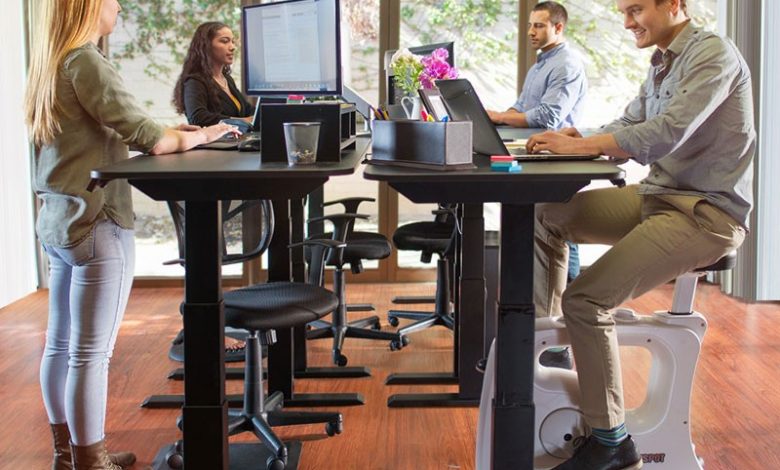Why Desk Exercise Tools Are Becoming Essential

Before we jump into the tools, let’s quickly understand why they’re so valuable.
Even if you exercise outside of work, sitting for the majority of the day still harms your health. Experts call this the “active couch potato effect”—someone who might run in the morning but still spends 8 hours sitting motionless afterward. The negative effects of sitting can’t be undone by one workout alone.
Desk exercise tools solve this problem by introducing low-impact, consistent movement throughout the day. This “movement snack” approach has been shown to:
- Burn more calories compared to sitting still.
- Improve circulation and reduce the risk of blood clots.
- Boost productivity by increasing energy and focus.
- Relieve stress and stiffness, especially in the neck, shoulders, and lower back.
- Engage muscles continuously, which can improve posture and reduce pain.
Now, let’s explore the five most effective tools you can start using today.
1. Under-Desk Elliptical Machines
What It Is
An under-desk elliptical is a compact pedal machine that mimics the elliptical motion of gym equipment. Unlike a treadmill desk (which requires standing), you can use this while sitting and working.
How It Works
Place the elliptical under your desk, and pedal with a smooth, gliding motion. Many models come with adjustable resistance, so you can increase intensity over time. Some also have digital monitors to track calories, distance, and speed.
Calories Burned
- Light pedaling: 100–150 calories per hour
- Moderate intensity: 200+ calories per hour
If you pedal for just 3 hours spread throughout your workday, you could burn 300–600 extra calories—equivalent to a gym session.
Benefits
- Low-impact cardio that’s easy on the knees.
- Quiet operation, so you can use it during meetings.
- Prevents stiffness and improves leg circulation.
- Suitable for all fitness levels.
Best Practice
- Start with 20–30 minutes per day.
- Gradually increase to 1–2 hours spread across your workday.
- Combine light pedaling with focused work tasks like reading or calls.
Pro Tip: Place your chair slightly further back from the desk to avoid your knees hitting the underside.
2. Desk Bikes (Under-Desk Cycles)
What It Is
Similar to an elliptical, a desk cycle is a small stationary bike that fits under your desk. The motion is circular, just like riding a bicycle.
How It Works
You sit in your chair, place your feet on the pedals, and start cycling while working. Some advanced models even come with built-in desks, turning the bike into a full workstation.
Calories Burned
- Light pedaling: 150–250 calories per hour
- Higher resistance: 300–400 calories per hour
This makes desk bikes one of the most effective Fat-burning exercise tools.
Benefits
- Strengthens lower body muscles (quads, hamstrings, calves).
- Improves endurance and cardiovascular health.
- Can double as an upper-body workout if you pedal with your arms (by placing it on the desk).
- Compact and portable.
Best Practice
- Use in short intervals—15–20 minutes per session.
- Try during meetings or brainstorming sessions when your hands are free.
- Add resistance gradually to build leg strength.
Pro Tip: Use a non-slip mat under the bike to prevent it from sliding as you pedal.
3. Balance Ball Chairs (Stability Ball Chairs)
What It Is
A balance ball chair combines a large stability ball with a supportive base and sometimes wheels. It looks like a quirky office chair but has powerful fitness benefits.
How It Works
The instability of the ball requires constant micro-adjustments from your body, which engages your core, lower back, and stabilizing muscles while you sit.
Calories Burned
- Burns about 6% more calories per hour than a standard office chair.
- That may sound small, but over an 8-hour workday, it can add up.
Benefits
- Improves posture and spinal alignment.
- Strengthens core muscles.
- Reduces lower back pain caused by static sitting.
- Can double as a workout tool for stretches, crunches, or yoga poses.
Best Practice
- Start with 1–2 hours per day.
- Alternate between your ergonomic chair and the balance ball chair.
- Ensure proper ball size: your knees should bend at a 90-degree angle when seated.
Pro Tip: Avoid using it all day, especially if you’re new—your core muscles need time to adapt.
4. Resistance Bands for Desk Workouts
What It Is
Resistance bands are one of the most versatile, portable, and affordable exercise tools you can use at your desk. They come in various resistance levels and can target every major muscle group.
How It Works
Keep a resistance band in your drawer. You can anchor it to your chair or desk and perform exercises like:
- Seated rows
- Bicep curls
- Tricep extensions
- Lateral raises
- Leg presses
Calories Burned
- A 15-minute resistance band workout can burn 100–150 calories.
- More importantly, resistance training builds muscle, which boosts metabolism and increases calorie burn even when resting.
Benefits
- Strengthens both upper and lower body.
- Improves posture by activating back and shoulder muscles.
- Helps combat “tech neck” and rounded shoulders.
- Small and inexpensive—perfect for home or office use.
Best Practice
- Do 5–10 minutes of resistance band exercises every couple of hours.
- Focus on posture-correcting moves (rows, reverse flys, band pull-aparts).
- Add progressive resistance over time for strength gains.
Pro Tip: Pair resistance band breaks with standing to maximize benefits.
5. Balance Boards for Standing Desks
What It Is
If you already use a standing desk, adding a balance board can take your activity to the next level. These boards wobble slightly, forcing you to engage your legs, hips, and core while you stand.
How It Works
Instead of standing still, you’re constantly shifting your weight to stay balanced. Some boards allow gentle rocking motions, while others offer multidirectional movement.
Calories Burned
- Standing burns 20% more calories than sitting.
- Using a balance board increases calorie burn to 150–250 calories per hour, depending on intensity.
Benefits
- Improves posture and spinal alignment.
- Strengthens core, legs, and stabilizer muscles.
- Prevents stiffness from static standing.
- Adds fun and movement to your workday.
Best Practice
- Alternate between standing and sitting every 30–60 minutes.
- Use the board in 20–30 minute sessions to avoid fatigue.
- Start with a rocker-style board if you’re new, then progress to multidirectional boards.
Pro Tip: Wear comfortable shoes or stand barefoot for better grip and muscle activation.
Quick Comparison: Which Tool Burns the Most Calories?
Here’s how they stack up:
| Desk Exercise Tool | Calories Burned Per Hour | Extra Benefits |
| Desk Bike / Under-Desk Cycle | 200–400 | Cardio + Leg Strength |
| Under-Desk Elliptical | 100–200 | Low-impact cardio |
| Balance Board + Standing Desk | 150–250 | Core + Posture |
| Resistance Bands | 100–150 (15 min workout) | Muscle building |
| Balance Ball Chair | Minimal (6% more than sitting) | Core + Posture |
Winner: The desk bike/under-desk cycle is the best for calorie burn.
But for posture and core health, balance boards and ball chairs take the lead.
How to Get the Most From Desk Exercise Tools
- Start gradually – Overdoing it on day one can lead to fatigue.
- Mix tools – Use a bike for calorie burn, a band for strength, and a ball chair for posture.
- Stay ergonomic – Adjust desk height and chair position for comfort.
- Set reminders – Use alarms or apps to prompt movement every hour.
- Pair with lifestyle habits – Hydrate, stretch, and take short standing breaks.
Final Thoughts
Desk exercise tools aren’t gimmicks—they’re practical solutions for fighting the health risks of sitting. Whether you want to burn calories, strengthen your core, or simply feel more energized, there’s a tool that fits your needs.
- Want maximum calorie burn? Go for a desk bike or under-desk elliptical.
- Want better posture and core strength? Try a balance ball chair or balance board.
- Want strength and flexibility? Keep resistance bands in your drawer.
Even small amounts of movement add up. By incorporating these tools into your daily routine, you can turn your workstation into a mini fitness hub, improve your health, and make your workday more productive and enjoyable.
FAQs
- Do desk exercise tools really help with weight loss?
Yes. While they don’t replace full workouts, consistent use can burn hundreds of calories per day and help with weight management. - Are under-desk bikes and ellipticals noisy?
Most quality models are quiet and smooth, making them office-friendly. - Can I use a stability ball instead of an office chair all day?
Not recommended. Start with short sessions (1–2 hours) and alternate with a regular chair. - Which tool is best for posture improvement?
Balance boards and ball chairs engage core and back muscles, helping to improve posture. - Do resistance bands actually build muscle?
Yes. They provide enough resistance to strengthen and tone muscles effectively.




